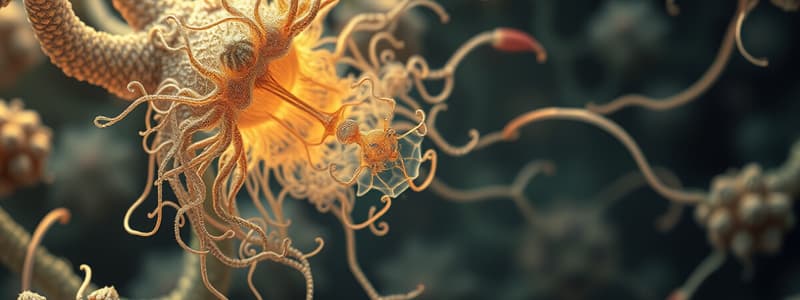Podcast
Questions and Answers
What type of division is observed in flagellates?
What type of division is observed in flagellates?
- Radial division
- Transverse division
- Longitudinal division (correct)
- Budding division
What term describes the active, feeding, and multiplying stage of most protozoa?
What term describes the active, feeding, and multiplying stage of most protozoa?
- Zygote
- Cyst
- Trophozoite (correct)
- Sporocyte
Which protozoan life stage is associated with pathogenesis in parasitic species?
Which protozoan life stage is associated with pathogenesis in parasitic species?
- Cyst
- Trophozoite (correct)
- Sporozoite
- Zygote
What is the process called when the nucleus divides several times before cytoplasm divides in asexual reproduction?
What is the process called when the nucleus divides several times before cytoplasm divides in asexual reproduction?
In the sexual cycle of apicomplexans, what is produced during gamogony?
In the sexual cycle of apicomplexans, what is produced during gamogony?
What type of organisms can arise from the excystation of cysts in some protozoa?
What type of organisms can arise from the excystation of cysts in some protozoa?
What stage follows the formation of a zygote in the life cycle of apicomplexans?
What stage follows the formation of a zygote in the life cycle of apicomplexans?
What is the term for the phase where a multinucleate schizont divides to form merozoites?
What is the term for the phase where a multinucleate schizont divides to form merozoites?
Which of the following protozoa can form cysts containing multiple infective forms?
Which of the following protozoa can form cysts containing multiple infective forms?
What structure is primarily used for movement in Volvox cells?
What structure is primarily used for movement in Volvox cells?
Which mode of reproduction can Volvox employ?
Which mode of reproduction can Volvox employ?
What is the mean infective dose of spores generally reported per bee?
What is the mean infective dose of spores generally reported per bee?
What disease is caused by Ichthyobodo necator in freshwater fish?
What disease is caused by Ichthyobodo necator in freshwater fish?
Which symptom is NOT associated with the infection characterized in bees?
Which symptom is NOT associated with the infection characterized in bees?
What differentiates Trypanosomatids from other protozoa?
What differentiates Trypanosomatids from other protozoa?
Which insect is the primary vector for Trypanosoma in the transmission of sleeping sickness?
Which insect is the primary vector for Trypanosoma in the transmission of sleeping sickness?
What type of organism is Glugea primarily associated with infecting?
What type of organism is Glugea primarily associated with infecting?
What type of host do Trypanosomatids primarily rely on in their life cycle?
What type of host do Trypanosomatids primarily rely on in their life cycle?
Which feature is characteristic of the phylum Ciliophora?
Which feature is characteristic of the phylum Ciliophora?
What is the primary consequence of Trypanosome entering the bloodstream of humans?
What is the primary consequence of Trypanosome entering the bloodstream of humans?
What reproductive process is common in ciliates?
What reproductive process is common in ciliates?
What is T. cruzi known to cause in humans and animals?
What is T. cruzi known to cause in humans and animals?
What disease is caused by Balantidium coli?
What disease is caused by Balantidium coli?
Where does Trypanosoma typically reside in its primary host?
Where does Trypanosoma typically reside in its primary host?
Which disease is NOT associated with Trypanosoma species?
Which disease is NOT associated with Trypanosoma species?
What organism transmits Chagas disease?
What organism transmits Chagas disease?
Which disease is caused by Giardia lamblia?
Which disease is caused by Giardia lamblia?
What is the primary mode of transmission for Leishmaniasis?
What is the primary mode of transmission for Leishmaniasis?
Which species of Trichomonas is known to inhabit the urogenital tract and may cause vaginitis?
Which species of Trichomonas is known to inhabit the urogenital tract and may cause vaginitis?
What characteristic differentiates Giardia lamblia from other intestinal pathogens?
What characteristic differentiates Giardia lamblia from other intestinal pathogens?
What type of organism is Leishmania classified as?
What type of organism is Leishmania classified as?
What type of organism is Opalina?
What type of organism is Opalina?
What characteristic is NOT associated with the phylum Sporozoa?
What characteristic is NOT associated with the phylum Sporozoa?
How is Trichomonas vaginalis primarily transmitted?
How is Trichomonas vaginalis primarily transmitted?
Which of the following is a class within the phylum Sporozoa?
Which of the following is a class within the phylum Sporozoa?
What is a common symptom of Chagas disease?
What is a common symptom of Chagas disease?
Where do the cysts of Giardia lamblia survive before being ingested?
Where do the cysts of Giardia lamblia survive before being ingested?
What is the main reproductive method of Sporozoa?
What is the main reproductive method of Sporozoa?
What type of environment do cysts of Giardia lamblia indicate regarding survival?
What type of environment do cysts of Giardia lamblia indicate regarding survival?
Coccidia are classified as what type of parasites?
Coccidia are classified as what type of parasites?
What disease is associated with the term 'coccidiosis'?
What disease is associated with the term 'coccidiosis'?
Which of the following organisms undergoes schizogony?
Which of the following organisms undergoes schizogony?
What is produced as a result of fertilization in the life cycle of Coccidia?
What is produced as a result of fertilization in the life cycle of Coccidia?
What is the role of sporogony in the Coccidia life cycle?
What is the role of sporogony in the Coccidia life cycle?
What is the main symptom caused by infections of Eimeria in domestic animals?
What is the main symptom caused by infections of Eimeria in domestic animals?
Flashcards are hidden until you start studying
Study Notes
Reproductive Strategies of Protozoa
- Division types in protozoa: longitudinal in flagellates, transverse in ciliates; amebas lack an apparent anterior-posterior axis.
- Schizogony is a common asexual division where the nucleus divides multiple times before the cytoplasm splits into smaller merozoites.
- In apicomplexans (e.g., Plasmodium, Toxoplasma), reproduction involves gamogony (gamete production), zygote fertilization, encystation into an oocyst, and sporozoite formation through sporogony.
Life Cycle Complexity
- Some protozoa have complex life cycles requiring two hosts, while others complete their life cycle within a single host.
- A single infective protozoan can generate a vast population, though reproduction is curtailed by the host’s death or immune defenses, leading to chronic infections.
Life Cycle Stages
- Trophozoite is the active stage where most protists feed and multiply; in parasites, this stage is often pathogenic.
- Hemoflagellates feature trophozoite stages identified as amastigote, promastigote, epimastigote, and trypomastigote, distinguished by flagellum presence and kinetoplast position.
- Merozoites result from a multinucleate schizont's fission; sexual stages include gametocytes and gametes.
- Some protozoa form cysts that multiply internally, with examples like Entamoeba histolytica producing multiple metacystic amebas upon excystation.
Specific Protozoa Examples
- Volvox: A single-celled organism exhibiting asexual or sexual reproduction with visible flagella, chromoplast, and stigma; cells interconnected by cytoplasmic strands.
- Ichthyobodo necator: A microscopic parasite infecting freshwater fish, leading to ichthyobodosis.
- Trypanosomatids: A kinetoplastid group with a single flagellum, exclusively parasitic, causing diseases like African sleeping sickness (Trypanosoma) and Chagas disease (Trypanosoma cruzi).
Trypanosoma Life Cycle
- Trypanosoma in humans is transmitted by the tsetse fly, causing initially fever, potentially progressing to sleeping sickness affecting the central nervous system.
- Trypanosoma cruzi causes Chagas disease, transmitted by the "kissing bug" via feces. Symptoms vary through the infection's course.
Leishmaniasis
- Transmitted by sandflies, leading to visceral leishmaniasis, important for both human health and veterinary contexts.
Giardia lamblia
- Often asymptomatic in humans, can cause severe diarrhea via fecal contamination; cysts release trophozoites in the intestine.
Trichomonas
- Several species are symbiotic; Trichomonas vaginalis is venereally transmitted and can cause vaginitis, while T. hominis exists non-pathogenically in the human intestine.
Phylum Ciliophora
- Characterized by the presence of cilia for locomotion, diverse in ecology, capable of both asexual (binary fission) and sexual (conjugation) reproduction.
- Ciliates are multinucleate, possessing macronuclei and micronuclei, with specialized structures and pellicles.
Balantidiasis
- An infectious disease caused by Balantidium coli affecting the digestive system, prevalent in the tropics and temperate regions.
Studying That Suits You
Use AI to generate personalized quizzes and flashcards to suit your learning preferences.




